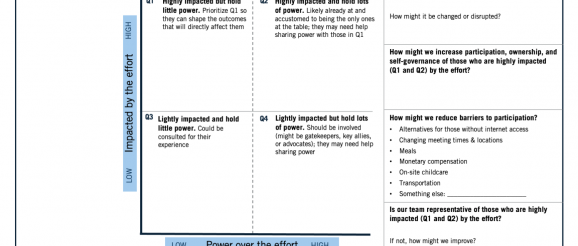Introducing the new ITK Stakeholder Power Categories tool! – Innovation Toolkit

Today’s blog is from Jonathan Rotner
Learn more about ITK’s newest tool and the equity lens embedded in it.
On first glance, this new tool might look like yet another 2×2 grid that helps your team prioritize its outcomes and actions. But this one comes from Team Toolkit, in collaboration with MITRE Social Justice Platform, so you know it drives outcomes and actions towards impact and equity.
Giving voice and a vote to those who are affected by an effort leads to more impact.
The ITK Stakeholder Power Categories tool prompts you to consider which stakeholder groups to prioritize, and it explores ways for you to integrate them into your teams. Using this tool can help your team adjust its goals, so they reflect the needs of those who will be most affected by the effort. It’s not walking a mile in someone else’s shoes, it’s walking that mile together!
Or, restating the goals of this tool in a more systems-engineering way, stakeholder engagement can be time-intensive, and this tool helps your team quickly categorize and assess which ones to engage, based on power and impact. For this activity, power over the effort refers to the ability to influence or control the behavior of people. Power comes in many forms: individuals have power, history has power, systems and the status quo have power, laws and norms have power, ideas and values have power, money has power. Impacted by the effort refers to the many ways that outcomes can affect an individual or group’s first-hand experiences.
Another goal of this tool is to highlight impacted stakeholders and to ideate on how to elevate their roles on your effort. Oftentimes, collaborating with those that are impacted will result in their endorsement of your effort and better outcomes for all. Deferring to those that are impacted may be the best way to ensure that the work continues and transitions to an engaged and invested community after your team moves on.
Direct participation from those who are overlooked or excluded leads to more equity.
A team’s assumptions about data, people’s behavior, potential uses, and the environment all shape an effort’s outcomes. These assumptions stem from team members’ own, often subconscious, social values, and they can be replicated and encoded into what the team designs. Unfortunately and unintentionally, those with the greatest need (i.e., those groups at the margins) often aren’t part of the design team; and so the final solution mimics the design team’s experience, rather than the lived experience of those with the greatest need. Therefore, the Stakeholder Power Categories tool asks how your team might increase participation, ownership, and self-governance of those who are highly impacted by the effort.
Direct participation by those at the margins is critical to reducing gaps in equity. These stakeholders can provide real context and experience in the domain where the effort will operate, and they can share information about how previous attempts to address their issues fared. These stakeholders can also help your team understand the different needs of different communities and how different approaches might distribute harm.[1]
Education and exposure are powerful tools. Sharing decision-making power has powerful outcomes. Equity-driven design thinking shows that when teams design for those at the margins, everyone benefits.[2]
So how might your team use the tool?
Start with the “when.” This tool is best used after you have identified a comprehensive and representative set of stakeholders that are relevant to the effort. (Or revisit this tool as the effort evolves, to ensure that the right set of stakeholders are still involved.)
The activity starts by helping your team get a better a sense of what the stakeholder landscape looks like, through the lenses of power and impact. The instructions first ask you to consider how much each stakeholder will be impacted by the effort. This section is intended to expand collaboration beyond the usual players.
Next, the instructions ask your team to consider the amount of power each stakeholder has over the effort. This part of the exercise helps your team think through the many ways in which inequality and internal assumptions can creep into the design, despite everyone’s best intent.
The “Notice and reflect” section promotes equitable outcomes. Before grappling with changing course or shuffling priorities, look at the 2×2 grid you just filled in. Read the quadrant descriptions and notice the patterns that have emerged: Are there any quadrants that are over- or under- represented? Did the team miss anyone?
The ITK Stakeholder Power Categories tool offers four questions that prompt your team towards different ways to make change. These questions suggest that those with lived experience (having personal knowledge or first-hand experience of the problem) are key contributors to a proposed solution. Answering these questions will not only help your team assess who should join the effort, but also help your team start to think through how you’ll invite them to do so.
And like all ITK tools, the final part of the tool reemphasizes that you act on your insights. What did your team discover after going through the exercise, and what will it do next?
Seriously, tell us! Team Toolkit can’t wait to hear about it.
Interested in learning more about other ITK tools with an embedded equity lens?
[1] “The Spectrum of Community Engagement to Ownership.” Facilitating Power Engagement approaches. Community Commons. Accessed June 29, 2021. [Online]. Available: https://d3n8a8pro7vhmx.cloudfront.net/facilitatingpower/pages/53/attachments/original/1596746165/CE2O_SPECTRUM_2020.pdf?1596746165
[2] “Design for the Margins: City Accelerator Guest Commentary.” YouTube, July 16, 2014. [Online]. Available: https://www.youtube.com/watch?v=Y7O9etlevyw
